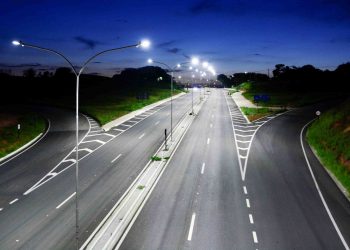
How to calculate the ROI for a street LED lighting project?
Saving public resources is essential for the development of any country. However, saving electricity is still a significant challenge for public sector managers. To make everything work properly, it is essential to make containment plans and apply strategies that promote expense reduction. But how can you know if the planned changes will really generate results?
In this post, we will explain how it is possible to calculate the ROI for an LED street lighting project and why this is so important for achieving greater energy efficiency. In addition, we will talk about the advantages of using this type of lamp to illuminate roads, as well as the consequences and losses of not doing the calculations correctly. Want to learn more about ROI calculation? Keep reading!
What are the advantages of using LED lamps to illuminate public roads?
There are numerous benefits of using LED luminaires in public lighting. The main one is economy, as one of the biggest expenses for municipalities is related to electrical installations in public areas and roads.
Using current equipment, results are visible in the short, medium, and long term. Mercury lamps are outdated and consume a huge amount of energy.
Another significant advantage is sustainability, which is already fundamental and entirely possible with luminaires manufactured with light-emitting diode (LED) technology. They avoid the emission of thousands of tons of carbon dioxide into the air and considerably reduce pollution in cities.
Street lighting needs to opt for LED options to protect the environment. Luminaires that use this technology generate less maintenance expenses, as they have a longer lifespan than others.
Thus, they may cost a little more, but within a short time, they will have compensated for the invested values. In addition, this option promotes safety and visual comfort, as the produced luminosity is wider and reduces crime rates.
Why is it important to calculate the ROI for an LED public lighting project?
Calculating the ROI (Return on Investment) is essential to evaluate the reach of energy efficiency – that is, to verify how much was saved or lost after investing in the installation of LED luminaires. This calculation also indicates how long the public manager will have to wait for the equipment to pay for themselves and start generating savings.
The importance of calculating ROI is that it allows setting goals and action plans based on accurate information. Thus, managers can eliminate unnecessary expenses and invest resources in other projects that they consider relevant to the public.
How is the calculation of ROI for LED street lighting projects performed?
The mathematical operation needs to consider the total cost of the investment and divide it by the economy that will be generated every month. In LED street lighting projects, the ROI calculation presents some variables and a straightforward method to obtain the return rate that will be obtained with the investment. The applied formula is:
ROI = Profit Obtained – Initial Investment / Initial Investment
Let’s assume that the Public Administration invests US$10 million in the installation of LED luminaires and manages to reduce the electricity bill from US$1 million to US$600,000. What will be the ROI in five years (60 months)? Let’s calculate it!
ROI = US$400,000 x 60 – US$10 million / US$10 million ROI = 1.4 or 140%
In this calculation, several factors of the specific case should also be considered, such as the system’s size, natural lighting or solar irradiation, the contracted supplier, the electricity tariff in the region, among others. It is worth noting that the higher the ROI calculation result, the higher the return that the investment will generate.
What are the particularities and impacts of ABNT 5101 standards on public lighting projects?
The Regulatory Standard of the Brazilian Association of Technical Standards ABNT NBR 5101:2018 establishes mandatory requirements for roadway lighting to provide safety for vehicle and pedestrian traffic. The original text was published in 2012 and was changed in 2018.
Thus, it established new rules for the implementation of lighting projects or street lighting. The issue is that they are not up to date, since technology has evolved significantly from 2018 to the present moment.
NBR classified the luminosity distribution considering transverse, longitudinal, or vertical distribution, and the control of 80 and 90 degrees above the cones, from the optical center of the luminaires.
A change was made regarding the transverse distribution, with the change of the Type II classification limit, dealing with the sides of the luminaires’ lighting intensities. The line of maximum half intensity, according to the 2012 text, remained between the longitudinal line of the road (LLV) 1.75 AM.
After the changes, the line of maximum half intensity can exceed LLV 1.0 AM but never exceed LLV 1.75AM in the space of the three distribution types. Another modification occurred in the requirements for uniformity and illuminance in the V3, V2, and V1 road classes, to meet the requirements of longitudinal, global uniformity, and average luminance:
- V3 – Roads with medium and heavy traffic (collectors, radials, urban roads that interconnect neighborhoods and with high pedestrian traffic);
- V2 – Roads with medium and heavy traffic (high-speed roads, with lane separation, two-way rural roads separated by obstacles, two-way roads with pedestrian crossings at defined points and intersections);
- V1 – Roads with medium and heavy traffic volume (highways, expressways, high-speed roads with separated lanes and no crossings).
The changes made were not significant and did not modify several criteria related to street lighting. They do not encompass current technological innovations. For this reason, it is expected that a new revision will be carried out as soon as possible. This will be essential to promote adequate lighting for public roads.
Now, you know how to calculate the ROI in LED street lighting projects and reduce energy consumption! Failing to make the appropriate calculations can lead to economic losses due to the maintenance of high costs seen in monthly electricity bills, as well as causing damage to nature, which must be preserved to ensure the survival of future generations!
Did you like the content? Share it! Want to know more about our LED lighting solutions? Request a quote right now!
Share







